Project your favorite movies at home onto a large screen, creating a movie theater experience. There are a lot of ways to enjoy time at home. One is to watch movies.
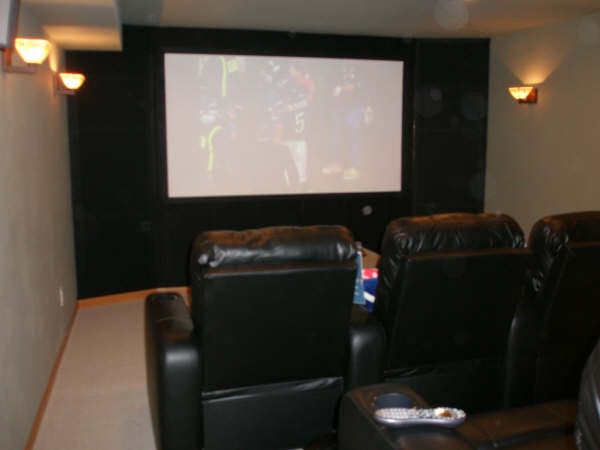
But you can make your movie-watching experience better by getting your own projector from a trusted manufacturer and projection screen innovations. Projector screens, especially ultra short throw ones, have the ability to turn your regular night into something more noteworthy.
Projector Screen
So, what are the best projector screens to buy in the world? First, decide what kind of gain you want. You’ll need to choose from several materials. You must carefully consider the (small) size you need. Aspect ratio is important when projecting. Make sure you also stay within a preset price range market for a sound solution.
Deciding What You Want In A Projector
The best ones fit the space you have. They’re large enough for the audience you expect. They are well-suited for your projector and are made of high-quality material. And they’re priced well for your budget. This article is about finding the ideal one for you to buy. Read on to find out how to choose yours.
Do Surfaces Matter?
The surface matters just as much as the machine you use to project. A good quality allows for better color variations, better clarity, a smoother setup, and even better audio, in some cases.
Some screens are designed to block audio from coming through the material, prioritizing performance over sound quality. They wouldn’t work well with a setup where the speakers are located behind the screen. Some are designed for use in dark rooms. Others are made for use outside. Choose one that matches the kind of viewing you’ll be doing.
Projector screens can make image quality coming from a high-end projector look washed out and blurry if they’re not a good match for the machine. This is particularly true for brands known for their high-quality displays. It’s not about buying the most expensive option you can find. It’s about matching the screens to the use, the projector, and the audience.
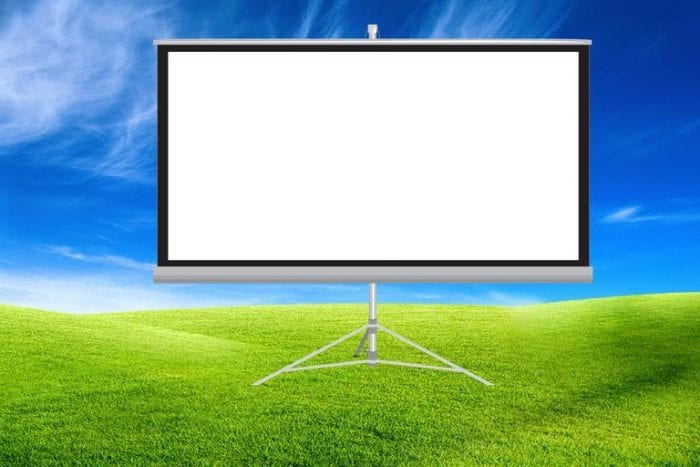
What Works Best For Projector Screens?
- The material used for a projector screen greatly affects image and video quality, ensuring top-notch performance tailored to different viewing environments. Projector screens are made from various materials to suit specific situations, each emphasizing performance differences between models. For example, a matte white screen is ideal for dark rooms, while others are better for high ambient light
Some projectors come equipped with multiple HDMI ports for easy connection to various devices, ensuring versatile usage. Others are a front projection. High contrast ones give you better contrast in the dark parts of pictures so it’s easier to see what’s going on.
Does Size Matter When Making Your Choice?
The screen size is important for optimal viewing experience. Base your choice on a few factors. How many people will typically be watching? Where are you putting it? What type of machine do you have? What type of media will you be showing?
Here’s how to choose a size. The height should be a sixth of the distance from the seats in the furthest row. Seating should start about twice the height away from the screen. Optimum placement is when the bottom of the screen is 4 feet off the floor. The width depends on the space available. Generally, you’ll want a wider one for a larger audience.
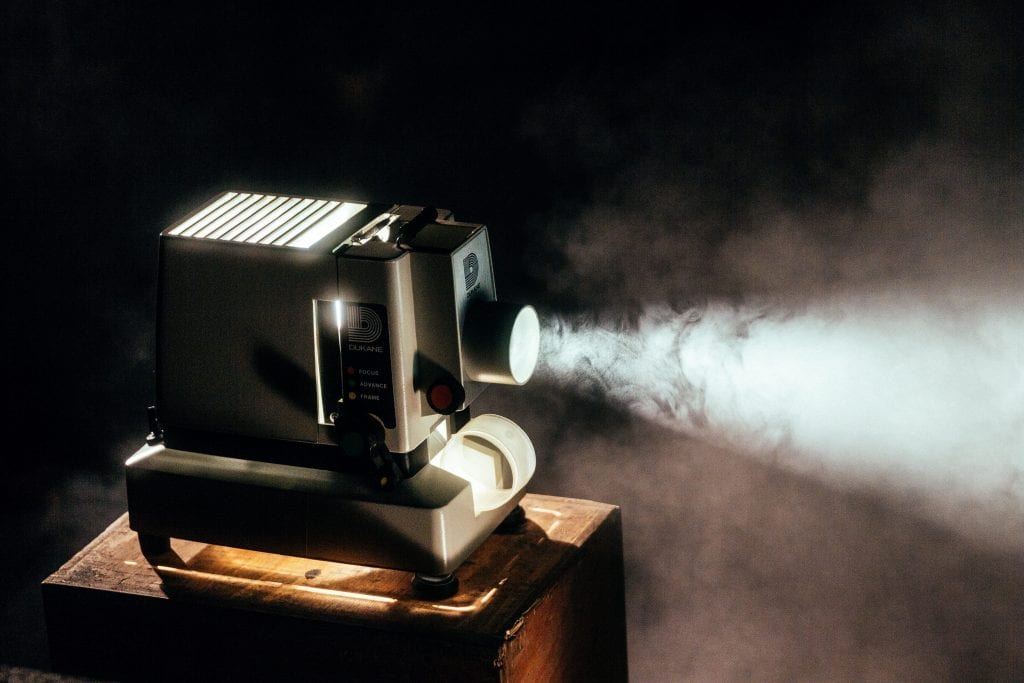
Good Aspect Ratio
The aspect ratio pertains to the relationship between the width and height of the screen, affecting the resolution of the projected image. When the width is larger than the height, you see a picture that’s rectangular. However, if the width and height are nearly the same, the picture quality display closer to a square.
Three aspect ratios are common—4:3, 16:9, and 16:10. Most home theaters have screens with a 16:9 aspect ratio. That’s because most of the content you’ll project at home comes from equipment that sends signals in a 16:9 aspect ratio.
The most common aspect ratio for presentations in meetings or at school is 4:3. The best match is a 4:3 projection screen for this kind of content.
Keep in mind, you can project 4:3 content onto a 16:9 or 16:10 surface. You’ll have black bars at the top and bottom or on the sides, though.
The Best Projector Screen
Ready to look at some screens for sale? Below is a list of some options available on Amazon, including a different product line to suit every budget, including options from popular companies or brands like Epson. Check them out and look for the features that serve your needs the best.
Mdbebbron 120 inch Projection Screen 16:9 HD Foldable Anti-Crease Portable Movies Screen
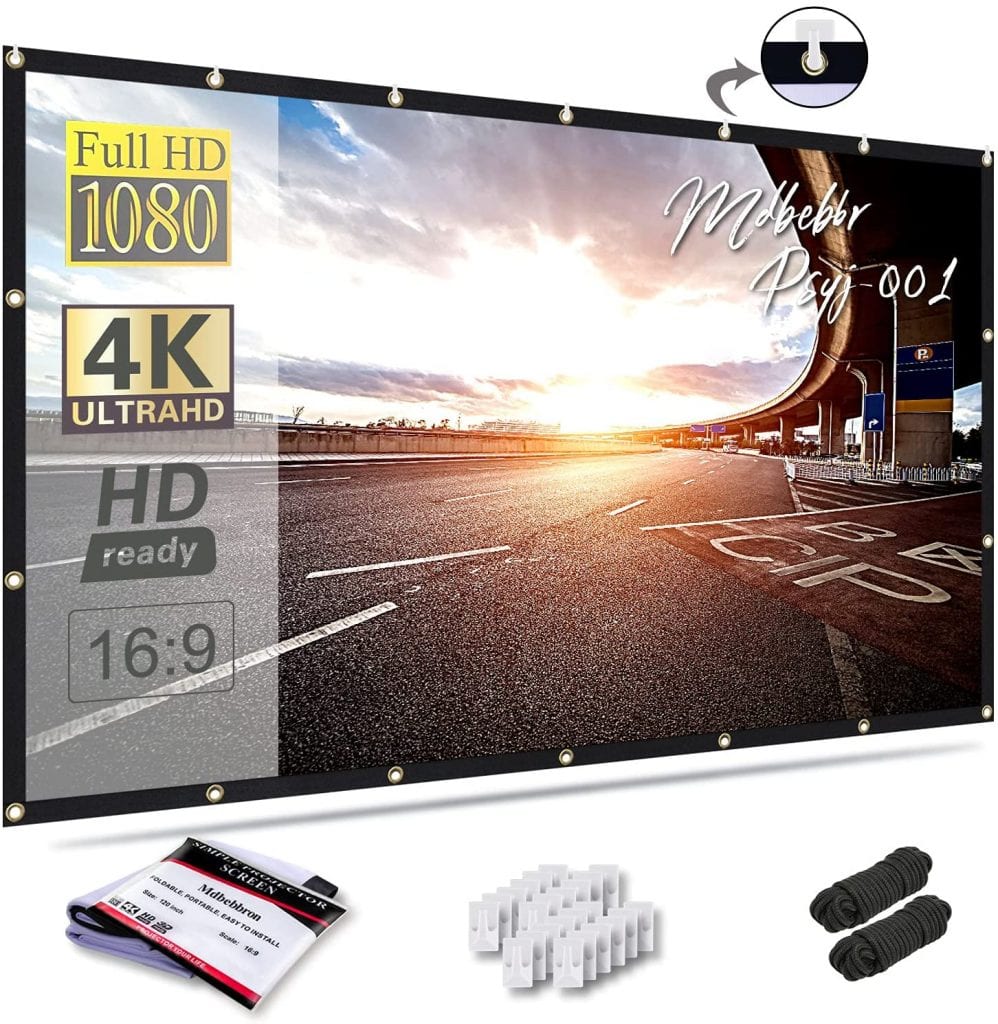
This is suitable for use indoors or outdoors. It doesn’t matter which side you project onto, and it’s double-sided. It’s easy to fold it up and take it with you camping or anywhere else you want. The anti-crease material makes it so you don’t have to worry about seeing lines during viewing sessions. It has an aspect ratio of 16:9. It’s lightweight, easy to set up with HDTV system settings, and made of light-absorbing material that produces a more vivid picture.
Pros:
- This proyector screen is highly affordable
- It is also portable and easy to transport
- Versatile
- This one is anti-crease and wrinkle for a smooth image
- Easy to clean by hand wash or machine wash
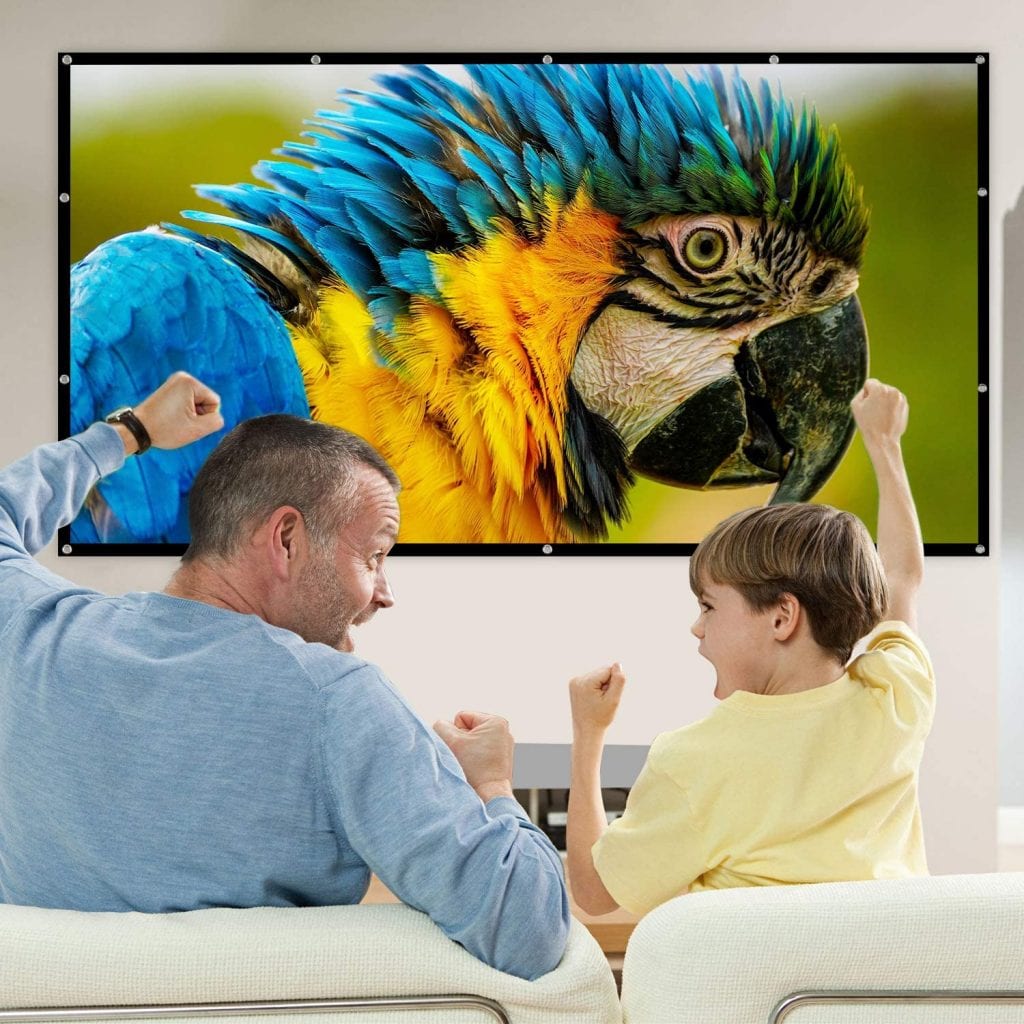
Cons:
- The hooks on this one for installation are unreliable
- This is also not waterproof
- It also needs a projection surface behind or light comes through
Projection Screens
Elite Manual B 100-Inch Manual Pull Down Screens
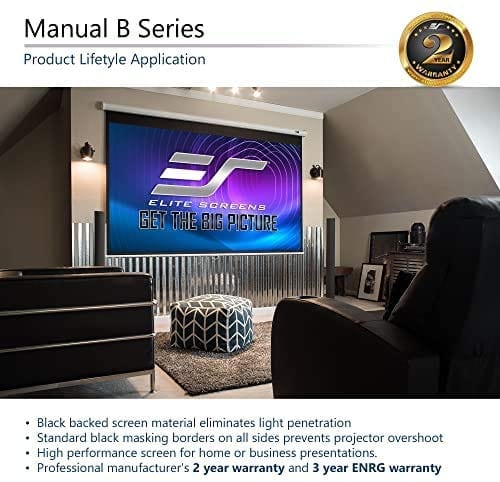
Elite Screens is one of the heavy hitters in the industry. They don’t make low-quality products. Products like this one are ideal for your home theater, especially for those looking to sell their property with added entertainment features. It has a 16:9 aspect ratio on a 100-inch screen. The manual pull-down mechanism allows you to pull it out when you need it and store it away when you don’t. Alternatively, consider an electric screen for effortless operation. There’s a slow retract roller inside to keep it safe from tears during the retraction process. An auto-lock engages to keep it positioned at whatever height you want.
Pros:
- Stores away when not in use
- Easy to install
- The screen has black backing to keep light from coming through
- Has a 180° viewing angle
- High-quality picture
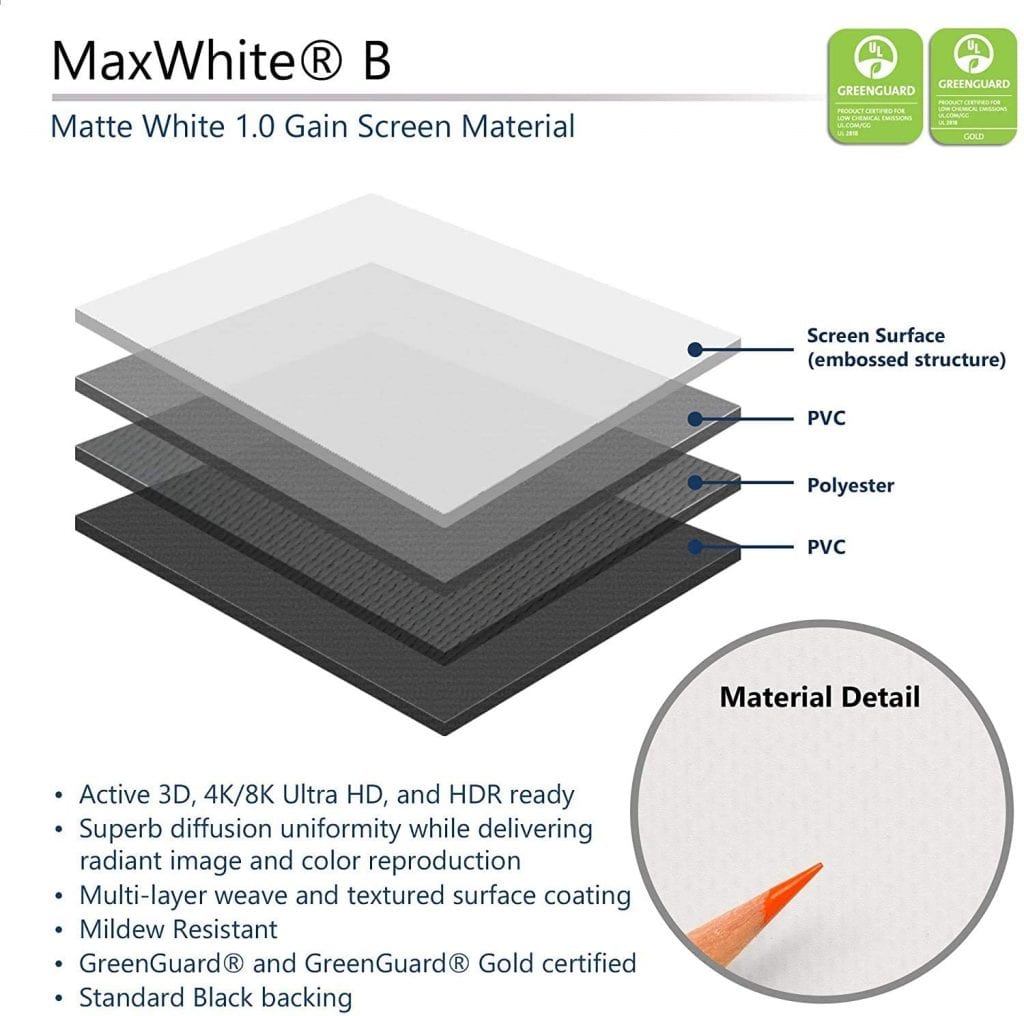
Cons:
- Heavy
- Not wrinkle-resistant
- Retraction is very slow
Projector Screens with Stand
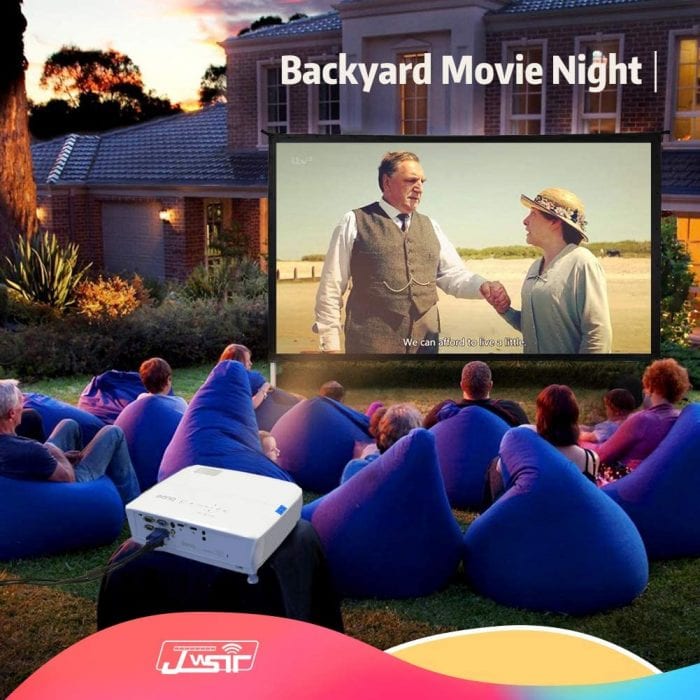
This is for use inside or outside. It has a layered screen that’s durable and doesn’t allow light to pass through. The material is foldable and is easy to transport in a carrying bag included with your purchase. The aspect ratio is 16:9 on 120-inches. You can set it up in just a few minutes. It is made of PVC matte material that is wrinkle-resistant and easy to clean.
Pros:
- The stand is included so don’t have to hang screen from anything
- No wrinkles to worry about
- Worry-free warranty included
- Carrying case included
- Clear picture
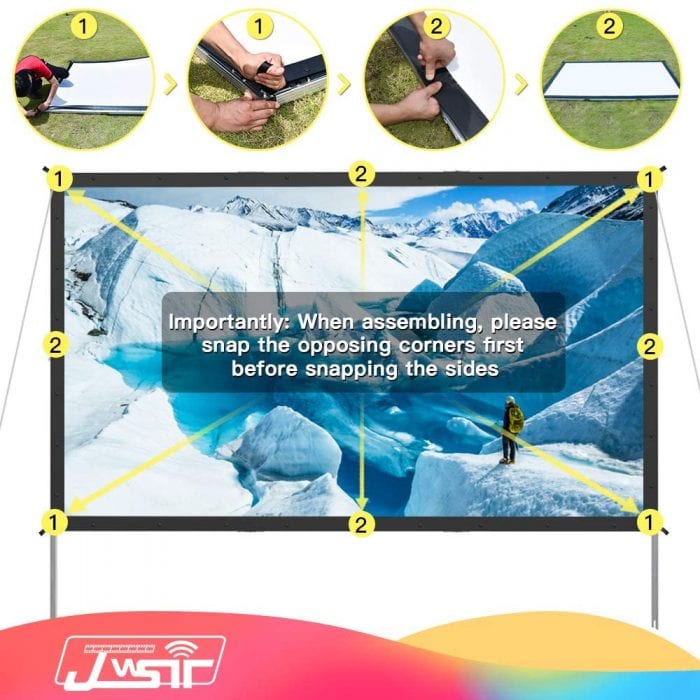
Cons:
- Hard to attach and detach screen from stand
- Assembly is tough for one person
Screen with Stand Foldable Portable Movie 100 Inch
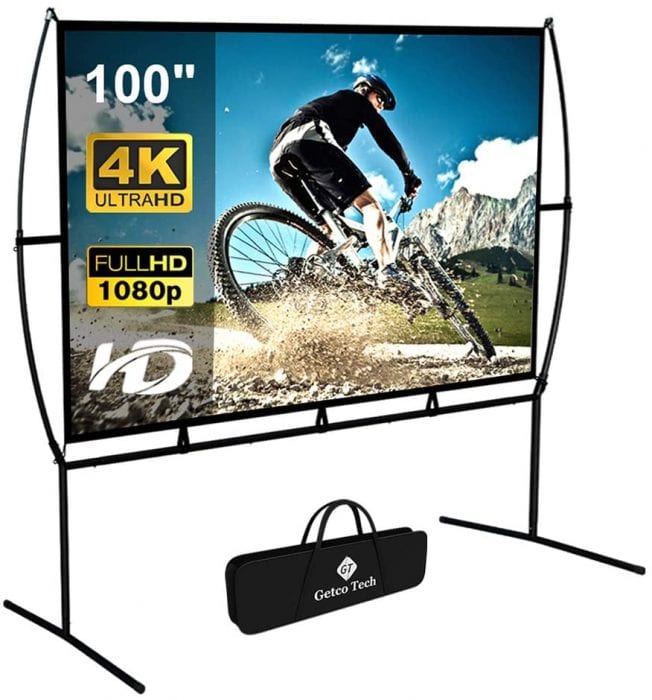
This has a 16:9 aspect ratio and a 160° viewing angle. It’s a lightweight, portable projection screen that is easy to assemble and convenient to transport in its own carrying bag. You can use this indoors or outdoors. It’s designed to be simple and assembled in just minutes. But it can enhance a high-quality viewing account experience.
Pros:
- Budget-friendly option
- Versatile for front or rear projection
- Convenient carrying bag included
- Frame is sturdy
- High-quality picture
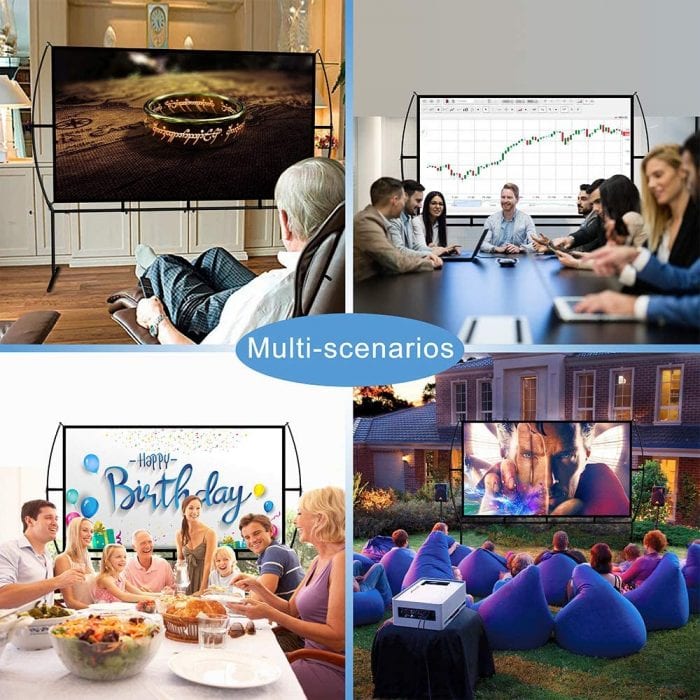
Cons:
- Assembly instructions aren’t great
- Top, center of screen bows down
Final Thoughts And Conclusion
- Projector screens provide a unique way to enjoy movies at home, offering a distinct experience compared to watching on an Android TV. Start your search for the perfect projector screen by browsing online shops for a wide selection. These screens often offer various light source options to enhance your viewing experience and some are suitable for outdoor use or are portable for on-the-go viewing. Look for the right size, aspect ratio, and material based on your space and budget. Movie nights at home will become unforgettable with the best projector screens.
Screen
Frequently Asked Questions:
How Much Do Projector Screens Usually Cost?
They tend to range in price, offering various buying options for every type of consumer. You’ll find prices as low as $30 from Sony or JVC to as high as a couple of thousand dollars.
Is Black Or White The Better Option?
Stock screens, such as those from reputable companies like BenQ, typically produce better dark parts of images. They’re also better for media room with a lot of ambient light. White ones reflect more light feedback and are more versatile.
Is Watching Movies Through Projectors Better Than Watching On TV?
This is a preference. TVs fixed frame on the wall edge have advanced technology built-in that has come down in price to levels that are affordable for most households. You can get a larger screen technology for less money with a projector, offering great value for customers seeking a cinematic experience at home. Many projectors can be easily installed on your ceiling for a streamlined setup. That convenience may be more worth it for some people.
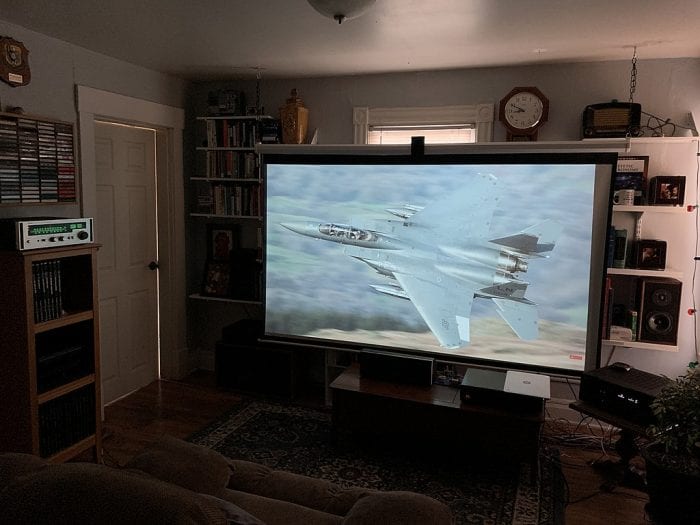
What is the best color when choosing a surface to project onto?
Project onto black for better contrast or choose a white screen for brighter pictures, or if you want more contrast in your colors onscreen. Alternatively, consider using a gray screen to save on power consumption in well-lit environments. Project onto white for brighter pictures and more versatile use.
Can I use a white tarp as a surface to watch films on?
White tarps can serve as screens with the right setup. You’ll want something to secure it to. You’ll also want a solid dark surface behind to keep light from coming through.
Can I use a bedsheet as an alternative?
A white or light-colored bedsheet can be used as a good surface when projecting. It needs to be secured tightly and have a dark surface behind it.
Are Cheap Options Worth It, Or Is This Something I Should Splurge On?
Many cheap ones aren’t worth it. There are some that are better than others. Don’t buy the bottom-rung-priced products. Spend a little more and you’ll get something that’s more worth your money.
What do you call the surface you use to project films and other media?
Are White Screens Better For Watching Movies?
Can a whiteboard also be used to watch films at home?
Why use screens for watching movies at home?
Can I watch a movie or video on my wall?
Can A Projector Still Be Used Without A Proper Screen?
Can You Use One In A Light Room?
Are Projectors Safer For The Eyes Than TV?
Last Updated on May 9, 2023 by Inma Barquero
DISCLAIMER (IMPORTANT): This information (including all text, images, audio, or other formats on FamilyHype.com) is not intended to be a substitute for informed professional advice, diagnosis, endorsement or treatment. You should not take any action or avoid taking action without consulting a qualified professional. Always seek the advice of your physician or other qualified health provider with any questions about medical conditions. Do not disregard professional medical advice or delay seeking advice or treatment because of something you have read here a FamilyHype.com.